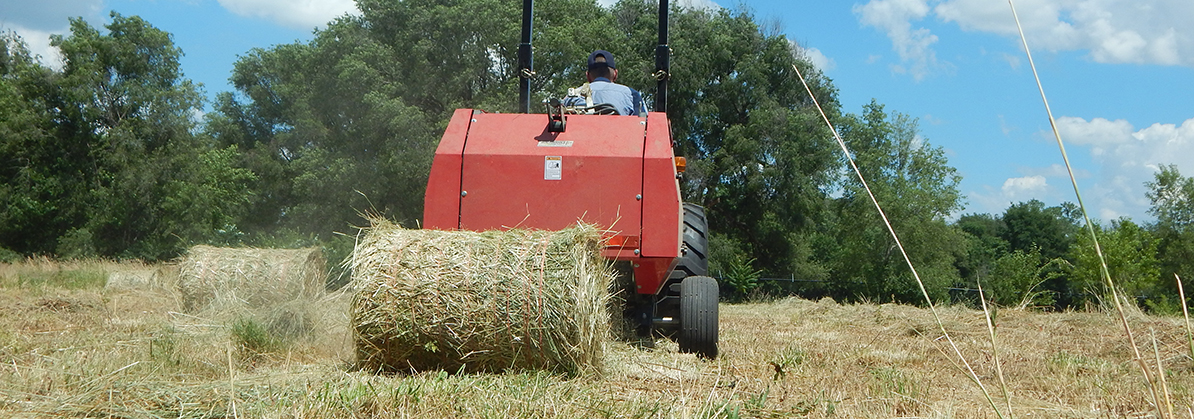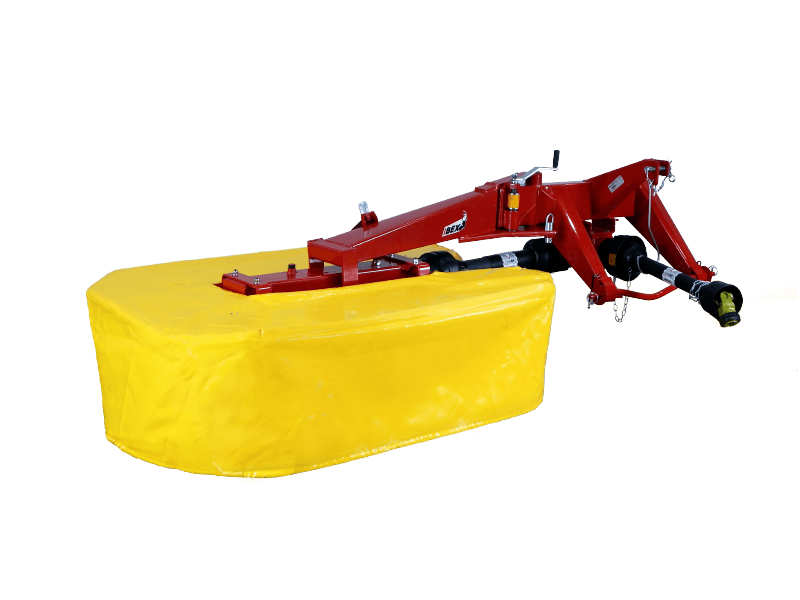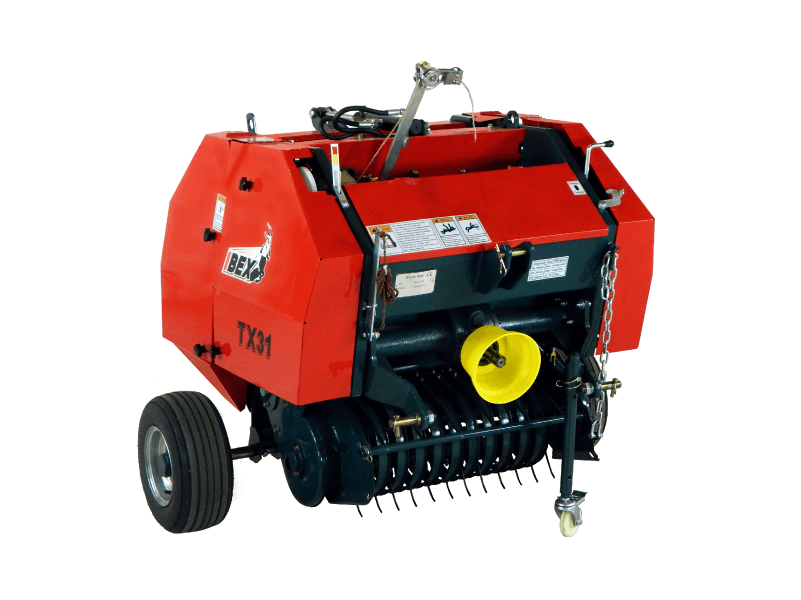Getting Started in Small-Farm Hay Production

You own a small farm with a few animals. You’ve decided you want to make your own hay. Maybe you’re tired of paying high prices for hay. Maybe you’re constantly disappointed by the quality of hay available. Maybe you’re fed up with the contract hay baler who doesn’t think your hay field is a priority.
Ultimately, you don’t want to depend upon others for quality hay to feed your animals. You know you can do better but you’ve got a small tractor, and everyone tells you it won’t be able to do the job. Maybe you’ve even been laughed at when you mentioned baling hay with your compact tractor to your farming neighbors.
Let it be known though–with the right knowledge and equipment, compact tractors do real work. Even the toughest work around—baling hay. The key to success is selecting the right equipment for your tractor and your property. We can help you get started.
In this blog, we will give you a brief overview of the equipment you will need to bring haying independence to your small farm. If, as you are reading, you would like more information on any of the implements mentioned, please visit our Buyer’s Guide at this link. This handy resource from our website includes specifications and comparison charts to help you choose the right equipment for your farm’s unique needs.
“Here at Tractor Tools Direct we can set you up for small-farm hay production with one of our hay baling packages designed to work with subcompact and compact tractors.”
These packages include a mower, rake, and baler at a discounted package price. To learn more about our other packages click here.
The Tractor
Before shopping for hay equipment, you must know the specifications of your tractor. Believe it or not, subcompact tractors with as little as 20 horsepower can be used to bale hay. Besides the horsepower, you need to know the weight of the tractor and its width, among other things. All of these factors combined will determine not only the size of hay equipment you can run, but also how safely you can run it. A tractor with too little weight and a high center of gravity on any slope at all can be a recipe for disaster. Knowing your tractor’s specifications and the power/weight requirements of your intended baling equipment is essential. Your tractor’s manual should have this information. However, if you don’t have the manual, there are many websites that can provide this information.
The Mower

The first step to the baling process is pretty obvious–cutting the hay. You will need to choose a mower that both fits your tractor and is right for the geography of your small farm as well as the type of forage you are intending to bale. There are three primary styles of hay mowers for smaller tractors: Sickle bar, disc, and drum. Each has its advantages and disadvantages. In order to choose the mower that will work best for your situation, first fit the mower to the size of your tractor and then determine how you will be using it.
Since sickle bar mowers are light weight and require little horsepower, they are a great match for many subcompact and compact tractors. They are also capable of angled mowing which makes them a little more versatile than the other two types of mowers. However, they tend to be the slowest of the three and can clog in dense material. Blade repair can also be time consuming and expensive.
Disc mowers handle thick hay with ease. They also have high cutting speeds. However, they can be too heavy for subcompact and some compact tractors to safely run. They can also be expensive to repair making it necessary to know that your pastures are clear of rocks and debris that could damage them.
Drum mowers are easily the most rugged of the hay mower types and tend to be the least expensive. They can be run without hydraulics and can be run at high speeds. They also have fewer moving parts and are easier for the farmer to work on. We recommend shaft-driven machines rather than beltdriven, keeping maintenance costs down.
The Tedder
A tedder is a machine that spreads and turns over cut, loose hay in the field. This action exposes the hay on the underside of a pile to air and sunlight, speeding up the drying process. Tedders use a rotary motion to grab the hay with spinning tines and cast it out the back of the machine.
Heavy hay in humid climates can dry faster by tedding. It is also an indispensable machine for spreading hay out to dry after a rain. Although some farmers get by without a tedder, it is smart to have a machine that can do this important job if and when you need it.
Tedders come in sizes as small as 6-feet wide—perfect for small farms. They don’t use much horsepower, so most any tractor with a PTO can run them. They come in both tow behind designs and 3-point connection. The advantage of the 3-point connection is that they can be lifted over obstacles like windrows, and they can be more easily transported. The disadvantage of the 3-point connection is that some tractors may have trouble lifting them.
Some rakes (covered later in this blog) will double as tedders, to varying degrees of success. Wheel rakes can flip a windrow over or can agitate hay that is spread in the field; however, they can leave clumps of hay that don’t dry well. Belt rakes can be easily converted to a tedder with the simple removal of a hay stop, and they truly spread the hay evenly as a tedder should. They are a great choice for a 2-in-1 machine.
The Rake

In order to bale hay, it must be raked into windrows. It is a common misconception that hay can be baled directly from the windrow or swath created by the hay mower. There are a few reasons why this will not work. First, in most climates, hay will not dry well unless fluffed, flipped, or turned by a tedder and/or rake. Secondly, the path left by the hay mower will generally not be conducive to being picked up by a baler, resulting in a lot of missed hay. Thirdly, you can normally rake at least two mower swaths into one windrow for baling, resulting in fewer passes across the field with the baler and better quality, more consistently dense bales. The choices for hay rakes are many.
Different regions of the country seem to prefer different styles of rakes. The four most prominent styles are wheel rakes, parallel bar (rollabar) rakes, rotary rakes, and belt rakes. Of these, wheel rakes tend to be the least expensive choice. They are also simple machines—simple to use and simple to repair. Parallel bar rakes, also relatively simple to use, are being replaced by other rake designs.
Rotary rakes are gentle on the crop and produce a fluffy windrow to cut drying time. They also handle wet crops well, adding to their versatility. They come in sizes for just about any tractor and are easy to maneuver. Belt rakes are the most versatile of all the rake types. Since they easily convert into a tedder, they are a 2-in-1 implement. They are light weight and come in sizes small enough for virtually any subcompact or compact tractor—a big perk for haying on a small farm.
The Baler

When it comes to choosing a baler, there are a multitude of choices. Even within the various categories of balers there are important distinctions. Since this discussion pertains to small-farm baling, we will concentrate on mini round balers and small square balers. Most small farmers do not have a large enough tractor in either weight or horsepower to consider a big round baler or big square baler. Furthermore, small-farm operators also tend to need more compact implements in order to bale in smaller paddocks and pastures.
The word is spreading about mini round balers. Once a rare oddity, many small-farm operators are finding that they are the best choice for getting hay in the barn. The mini round baler works on the same principle as its bigger cousin, rolling the hay inside a chamber until it reaches a certain size, and then wrapping the bale with either twine or net and ejecting it out the rear of the machine.
Mini round balers are a great choice for small-farm forage production. Requiring only around 15 HP to operate, they can be run by the subcompact/compact tractors so popular with small-farm operators today. They are also light weight making them safer to operate on slopes. They have a simpler design than square balers, with fewer adjustments required and fewer parts to break—a perk for those just starting out in forage production.
Mini round balers are also available with the option of wrapping the bale in netting rather than string. This provides protection against rain and moisture. It also reduces material loss which is especially helpful if the bales will be handled a lot.
Though mini round balers cannot produce as many bales per hour as a square baler, they are less expensive to purchase and easier to maintain. They also are easier to navigate in the smaller and oftentimes irregularly shaped pastures found on small farms.
Square balers can work quickly and continuously, dropping a new bale in the field as often as every 10 seconds or less. However, once the bales are on the ground, getting them in the barn becomes a high priority. Square bales left in the field overnight will tend to soak up dew and moisture from the ground.
Most standard square balers on the market require 35 horsepower at your tractor’s PTO, and a minimum tractor weight of around 3000 pounds. That means that they cannot be run with today’s compact tractors. This can be a problem for small-farm operators who want square bales but don’t want to run a larger tractor. However, some brands of square balers, like Abbriata, can be operated with tractors of as little as 20 PTO horsepower and weight of as little as 2300 pounds. On flat ground, even lighter weight tractors are sufficient.
Square balers, while having a high baling capacity, are mechanically complicated. A decent amount of mechanical prowess is helpful when operating a square baler. It is also important to keep in mind that a square baler is quite heavy compared to a mini round baler. If you are baling steep slopes or have a very small tractor, a square baler’s weight can become hazardous.
Conclusion
Getting started in hay baling on a small farm doesn’t have to be a daunting task. Even for novice farmers, a little bit of research can go a long way. Hopefully this blog has given you the information you need to select the equipment that will perform best on your small farm and meet your unique forage needs. Again, please be sure to check out our “Buyer’s Guide” for more information and for links to specific implements. Also, be sure to check out our hay packages here.
You can bale hay on a small farm with a compact tractor. You just need to know how. Make 2019 the year you bring haying independence to your small farm!
Recent Posts
-
Boost Pine Straw Production Efficiency with Ibex Mini Round Balers
At Tractor Tools Direct, we're known for our high-quality hay equipment tailored for small farms …Dec 8th 2025 -
How to Winterize Your Tractor: Essential Maintenance Tips to Protect Your Investment
Farm equipment is one of the most valuable investments a farmer can make. At Tractor Tools Direc …Dec 1st 2025 -
Farm Tax ID Explained: Benefits, Eligibility, and How to Apply
As the end of the financial year approaches, it's a great time for small farmer operators to rev …Nov 12th 2025




